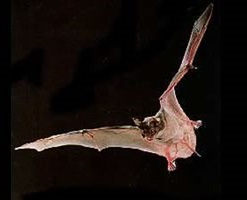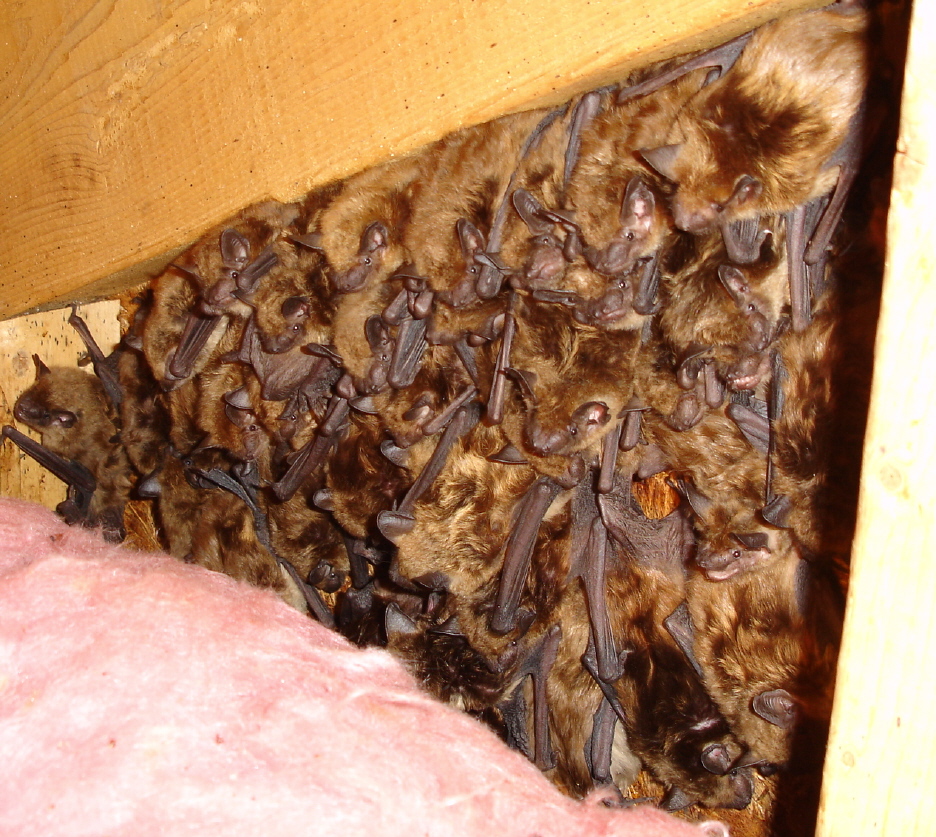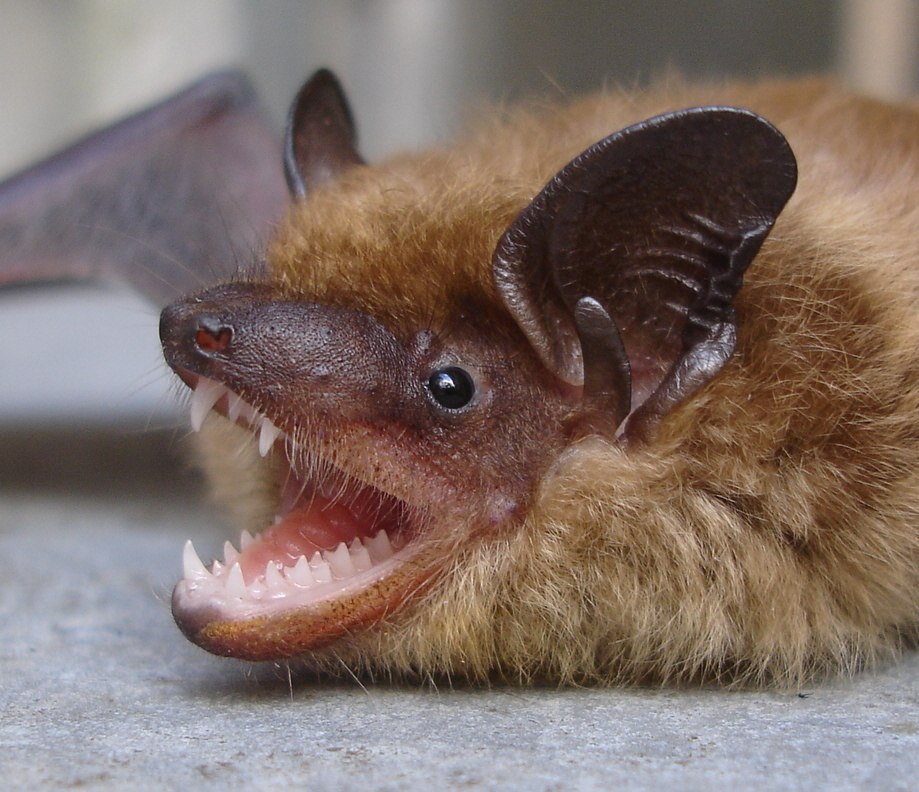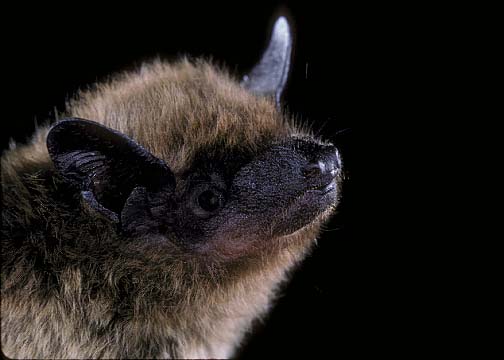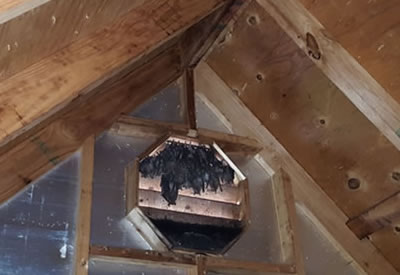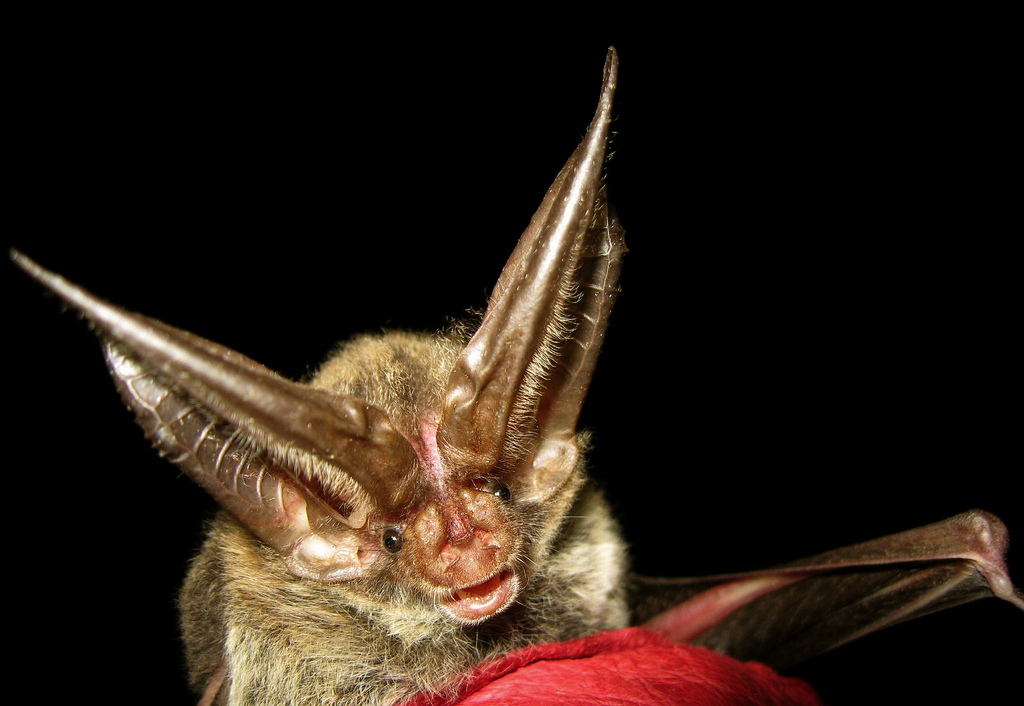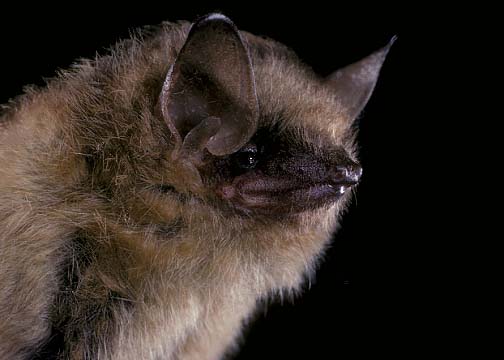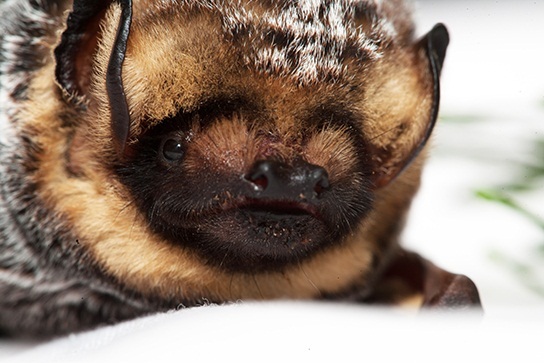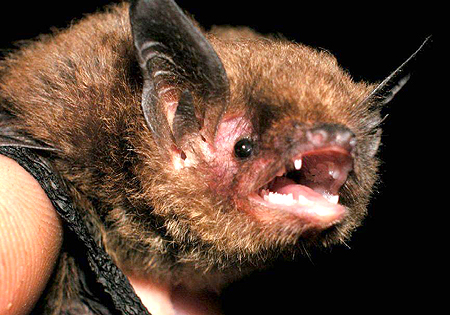
BATS
Our Wildlife Specialists will target bats already nesting within your dwelling. We then provide exclusion services that ensure that bats don’t have access to your structure later on. Exclusion is in layman’s terms, pest-proofing. It is the process of eliminating any potential entry point for bats and other pests.
Arkansas Bats
Big Brown Bat
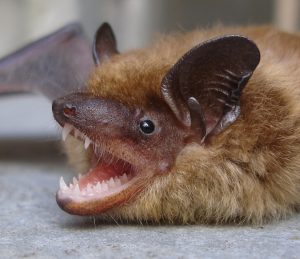
This medium-sized bat ranges from 4 to 5 in body length, with an 11- to 13-in wingspan, and weighs between 1/2 and 5/8 oz. The fur is moderately long and shiny brown. The wing membranes, ears, feet, and face are dark brown to blackish in color. Young big brown bats are able to fly at about three to five weeks old and reach adult size after about two and a half months. The male big brown bat reaches sexual maturity in its first autumn, but only some females reproduce at the end of their first year. The big brown bat may potentially live for 19 or 20 years in the wild, but many die in their first winter. A common cause of mortality in the big brown bat is failure to store enough fat for hibernation, although this species is also occasionally taken by predators such as owls.
Brazilian Free-Tailed Bat

The Mexican free-tailed bat, also known as the Brazilian free-tailed bat and Austonian bridge bat, is a medium-sized bat that is native to the Americas and is widely regarded as one of the most abundant mammals in North America. The Brazilian free-tailed bat is named that because its tail extends beyond its tail membrane. This bat lives in colonies. It is a very fast flier. In Arkansas, the freetail bat is found mostly in the southern and eastern parts of the state.
Eastern Pipistrelle

This reddish, yellowish and brownish bat is one of the smallest bats in eastern North America. It is around three inches long with about a seven inch wingspan. The forearms are orange to red, and the wing membrane is black. They are easily distinguished from other similar species by their tri-colored fur. These bats were renamed by Dr. Paul Cryan with US Geological survey to the Tri-Color Bat.
Eastern Red Bat
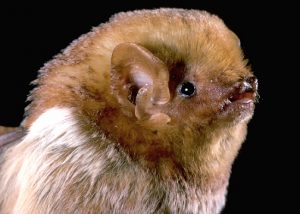
This is a medium-sized Vespertilionid, averaging weights of 9.5-14 g and measurements of 112.3 mm in total length. Adults are usually dimorphic: males have red hair while females are chestnut-colored with whitish frosting on the tips of the fur. The Red Bat is probably the most common bat in Arkansas. It is usually the first bat to come out in the evening, even before dark. It is normally found in trees, but it is hard to spot because it can look just like a dead leaf!
Evening Bat
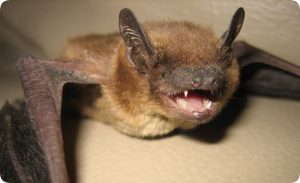
The evening bat is a species of bat in the vesper bat family, Vespertilionidae, that is native to North America. It is a small bat found throughout much of the midwestern and eastern United States as well as northeastern Mexico.
Gray Bat

The gray bat once flourished in caves all over the southeastern United States, but due to human disturbance, gray bat populations declined severely during the early and mid-portion of the 20th century. The Gray Bat is also found in Arkansas. It occurs primarily in the Ozarks, where they have pups only in a few special “maternity caves.” For this reason, it is considered to be an endangered species.
Hoary Bat

The hoary bat is a species of bat in the vesper bat family, Vespertilionidae. It occurs throughout most of North America and much of South America, with disjunct populations in the Galápagos Islands. The Hoary Bat is one of the larger bats in Arkansas with a wingspan of about 16 inches. Its name is due to the effect of having white tips on the hairs. It is one of the largest bats in the U.S. It likes evergreen trees and eats moths.
Indiana Bat
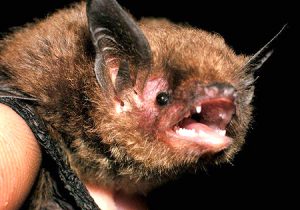
The Indiana bat is a medium-sized mouse-eared bat native to North America. It lives primarily southern and midwestern states and in parts of the south of the United States. The Indiana bat is gray, black, or chestnut in color and is 1.2 – 2 inches and weighs 0.16 – 0.34 oz. It is similar in appearance to the more common little brown bat but is distinguished by its feet size, toe hair length, pink lips and a keel on the calcar. Indiana bats live in hardwood forests and hardwood-pine forests. It is common in old-growth forest as well as in agricultural land like croplands and old fields. Overall, the bats mostly live in forest, crop fields, and grasslands. As an insectivore, the bat will eat both terrestrial and aquatic flying insects like moths, beetles, and mosquitoes and midges.
The Indiana bat is listed as an endangered species by the U.S. Fish and Wildlife Service. It has had serious population decline, estimated to be more than 50% over the past 10 years, based on direct observation and a decline on its extent of occurrence.
Little Brown Bat

The little brown bat is one of the most common bats of North America. The little brown bat has been a model organism for studying bats. Range and ecology.
The little brown bat is found throughout much of North America. It is most common in the northern half of the continental United States and southern Canada. Most specimens from the northern edge of its range are males although nursery roosts have been found in the Yukon.
The little brown bat lives in three different roosting sites: day roosts, night roost and hibernation roosts. Bats use day and night roosts during spring, summer and fall. Day roosts are usually found in buildings or trees, under rocks or wood piles and sometimes in caves. Nursery roosts are found in both natural hollows and in buildings. Night roosts tend to be in the same buildings as day roost. Bats rest in night roosts after feeding in the evening which may serve to keep their feces away from the day roosts and thus less noticeable to predators. Brown bats typically hibernate in caves and perhaps unused mines. Northern populations of bats enter hibernation in early September and end in mid-May while southern populations enter in November and ends mid-March.
Northern Long-Eared Bat
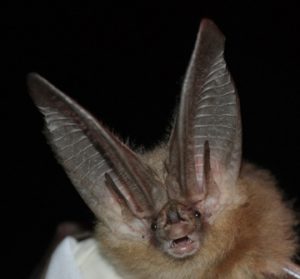
Northern Long-eared Bat, A Threatened species in some areas, is usually a dull or light brown color, with a gray underbelly. Habitat for the summer may include day roosts in buildings, under tree bark or shutters.
Rafinesque’s Big-Eared Bat
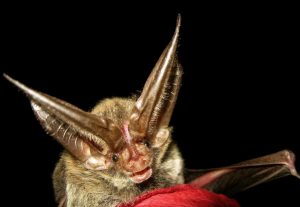
Rafinesque’s big-eared bat is a medium-sized gray bat with a white underside. It has large ears measuring more than 1 inch in length, and two large lumps on the snout. Females form maternity colonies of up to several dozen individuals in building and sometimes in caves. Males roost singly during this time in buildings, behind loose tree bark and in hollow trees. They generally hibernate in caves or abandoned mines.
Southeastern Bat
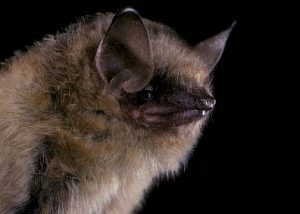
The southeastern myotis weighs 1-3 oz. Its diet consists predominantly of insects. The Southeastern Bat, rest by day and forage at night. They often hunt and feed over water. The feeding flights usually alternate with periods of rest, during which the bats hang to digest their catch. The southeastern bat has a wingspan of about 9-11 inches. Pelage varies from gray to bright orange-brown, with females generally being more brightly colored than the males. Southeastern bats are unique among Myotis of the United States in the production of twins; all other Myotis females usually produce one baby.
Townsend Big-Eared Bat

Townsend’s Big-eared Bat is found only in northwest Arkansas. A similar species called Rafinesque’s Big-eared Bat occurs in southern and eastern Arkansas. Townsend’s big-eared bats will use a variety of habitats, almost always near caves or other roosting areas. They can be found in pine forests and arid desert scrub habitats. When roosting they do not tuck themselves into cracks and crevices like many bat species do, but prefer large open areas. Their wingspan is 12-13 in. and they weigh between 0.3-0.5 oz. These bats can be found throughout the western U.S. from British Columbia down into central Mexico.
Treatments and preventions
Bat exclusion is the best and safest way for you, your home, and the bats. This process allows the bats a way to fly out of the area, but not back inside. Trapping bats is not recommended! Sealing the bat entry points is done before the exclusion in order to prevent more from gaining access into your property. This is to ensure the best results for the exclusion job. The area in question will need to be cleaned thoroughly once all the bats have left. If required, the cleaning process can go beyond using a Hepa Vacuum to collect the bat guano. If this is the case, a multi-step process could be needed. This includes vacuuming loose guano from the surfaces, and using an enzyme-based cleaner to sanitize. If the insulation in your attic is soiled, it will need to be removed. If it isn’t too serious, it can be sprayed with a cleaner. Sometimes a fogger is needed to get to all the nooks and crannies. Regardless of the level of bat excrement, cleaning is necessary for health reasons, and in extreme cases, the structural integrity of the wood in your attic. Some people have found a small silver lining in their bat experience and use the vacuumed excrement as fertilizer in their gardens.
Basic Facts About Bats
Diet
70% of bats consume insects, sharing a large part of natural pest control. There are also fruit-eating bats; nectar-eating bats; carnivorous bats that prey on small mammals, birds, lizards and frogs; fish-eating bats, and perhaps most famously, the blood-sucking vampire bats of South America.
Population
While some bat populations number in the millions, others are dangerously low or in decline.

Cloud of Bats in a Gable Vent.
Behavior
Echolocation – Some bats have evolved a highly sophisticated sense of hearing. They emit sounds that bounce off of objects in their path, sending echoes back to the bats. From these echoes, the bats can determine the size of objects, how far away they are, how fast they are traveling and even their texture, all in a split second.
Bats find shelter in caves, crevices, tree cavities and buildings. Some species are solitary while others form colonies of more than a million individuals.
Overwintering – To survive the winter some species of bat migrate, others hibernate, and yet others go into torpor (regulated hypothermia that can last from a few hours to a few months).
Reproduction
Gestation: 40 days – 6 months (bigger bats have longer gestation periods)
Litter Size: Mostly one pup.
For their size, bats are the slowest reproducing mammals on Earth. At birth, a pup weighs up to 25 percent of its mother’s body weight, which is like a human mother giving birth to a 31 pound baby! Offspring typically are cared for in maternity colonies, where females congregate to bear and raise the young. Male bats do not help to raise the pups.
When you finish reading our list of incredible bat facts, you may have a much different opinion of bats than you did before.
Fun Facts about Bats
1. Bats are the only mammals able to fly. And you thought it was the winged marmoset! Bats are exceptional in the air. With elongated fingers and a wing membrane stretched between, the bat’s wing anatomically resembles the human hand, giving them what is called, in flight terms, “airfoil”. The power bats have to push forward is called “propulsion”.
2. A single brown bat can catch around 1,200 mosquito-size insects in one hour. In Bracken Cave, Texas, it’s estimated that the 20 million Mexican free-tailed bats that live there eat about 200 tons of insects . . . each night.
3. Vampire bats don’t suck blood. They lap it up. There are only three species of vampire bats in the whole world. If you are traveling in Central or South America, however, you might see a vampire bat bite a cow and then lick blood from the wound — no sucking involved.
4. Other Dietary Needs. There are also fruit-eating bats; nectar-eating bats; carnivorous bats that prey on small mammals, birds, lizards and frogs; fish-eating bats, and perhaps most famously, the blood-sucking vampire bats of South America.

5. Bats don’t have “fat days.” The metabolism of a bat is enviable — they can digest bananas, mangoes, and berries in about 20 minutes.
6. Fewer than 10 people in the last 50 years have contracted rabies from North American bats. Due to movies and television, bats are thought to be germ machines, bringing disease and toxins to innocent victims. Not true. Bats avoid people. If you are bitten by a bat, go to the doctor, but don’t start making funeral arrangements — you’ll probably be fine.
7. Bats use echolocation to get around in the dark. Bats don’t see very well and do a lot of living at night, so they have to rely on navigational methods other than sight. Bats send out beeps and listen for variations in the echoes that bounce back at them and that’s how they get around. Bats are nocturnal, mostly because it’s easier to hunt bugs and stay out of the way of predators when it’s dark. Bats do use their eyesight to see things in the daytime, but most bat business is done under the blanket of night for convenience.
8. Bats make up a quarter of all mammals. Yep, you read that right. A quarter of all mammals are bats. There are more than 1,100 species of bats in the world. That’s a lot of bats!
9. More than 50 percent of bat species in the United States are either in severe decline or are listed as endangered. You don’t know what you’ve got until it’s gone. Industry, deforestation, pollution, and good old-fashioned killing have wiped out many bats and their habitats. For information on how to help keep bats around, contact your local conservation society.
10. Cold night? Curl up next to a bat! Inside those drafty caves they like so much, bats keep warm by folding their wings around them, trapping air against their bodies for instant insulation.
11. An anticoagulant found in vampire bat saliva may soon be used to treat human cardiac patients. The same stuff that keeps blood flowing from vampire bats’ prey seems to keep blood flowing in human beings, too. Scientists in several countries are trying to copy the enzymes found in vampire bat saliva to treat heart conditions and stop the effects of strokes in humans.
12. Bats have only one pup a year. Most mammals of smallish size have way more offspring than that. Think cats, rabbits, and rats.
13. The average bat will probably outlive your pet dog. The average lifespan of a bat varies, but some species of brown bat can live to be almost 40 years old. Considering that other small mammals live only two years or so, that’s impressive.
14. Bats wash behind their ears. Bats spend more time grooming themselves than even the most image-obsessed teenager. They clean themselves and each other meticulously by licking and scratching for hours.
15. Bats can be found almost anywhere in the world except the Polar Regions and Extreme Deserts
16. Largest Bat. Giant flying foxes that live in Indonesia have wingspans of nearly six feet!

17. Smallest Bat. Kitti’s hog-nosed bat. Also known as Bumblebee Bat.
 Little Rock, AR 501-868-3837 | Russellville, AR 479-968-4777 | Hot Springs, AR 501-442-5653 | Fayetteville, AR 479-899-6874
Little Rock, AR 501-868-3837 | Russellville, AR 479-968-4777 | Hot Springs, AR 501-442-5653 | Fayetteville, AR 479-899-6874


